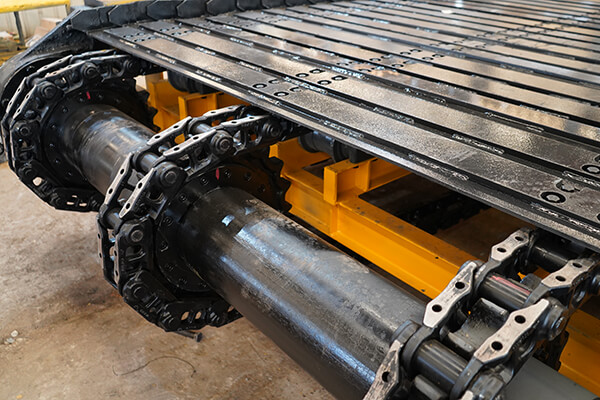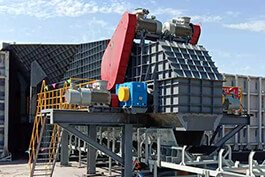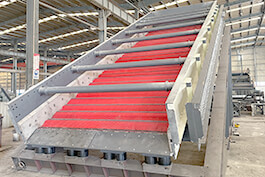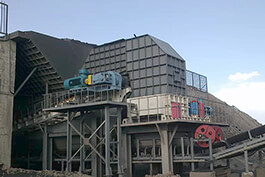Introduction
When the apron feeder suddenly makes strange noises, experiences transportation delays, or even stops unexpectedly, would you first check the sprocket? The sprocket is by no means a passive transmission component; it controls the rhythm of material transportation. The sprocket transmits power smoothly and continuously through a tight meshing with the chain, ensuring that each piece of material moves along the predetermined trajectory and at the prescribed speed. The design of the sprocket must fully consider wear resistance and impact resistance to cope with various harsh working conditions and guarantee the long-term stable operation of the apron feeder. This article will guide you to understand the true function of the sprocket.
Function of Sprockets in Apron Feeders
Transmitting power and traction
Power input end (head sprocket): The power provided by the motor is transmitted to the head sprocket through transmission devices such as a reducer. The sprocket, through its engagement with the chain, converts the rotational torque into a powerful traction force that pulls the entire chain (and the chain plates installed on it) forward.
Drive end (tail sprocket): The tail sprocket usually does not provide power. Its main function is to support the chain and guide it to change direction, forming the return stroke.
Engagement and Guidance
Preventing slippage: The tooth shape of the sprocket can precisely mesh with the rollers of the chain, unlike belt transmission, this meshing method ensures the synchronization of power transmission and avoids the phenomenon of slippage, which is crucial for apron feeders that require precise control of the feeding amount.
Stabilizing the chain trajectory: The sprocket provides a clear running trajectory for the chain, preventing lateral oscillation or skipping teeth of the chain when running at high speed or under heavy load, ensuring the smoothness and reliability of the apron feeder operation.

Support and Bearing
The sprocket needs to withstand the huge tension from the chain. This tension includes the weight of the chain itself, the weight of the materials on the chain plates, as well as the dynamic and impact loads generated by the chain during operation. Therefore, the sprocket itself must have extremely high strength and stiffness.
Controlling chain length and tension
The center distance of the sprocket is one of the key factors determining the total length and tension of the chain. By adjusting the center distance between the head and tail sprockets (usually with a tensioning device designed at the tail), an appropriate preload can be applied to the chain, ensuring proper meshing and avoiding jittering, skipping teeth, or increased wear.
Manufacturing Process of the Apron feeder Sprocket
Forging process
Process flow
Cutting → Heating → Forging (die forging / free forging) → Heat treatment (normalizing, quenching and tempering) → Mechanical processing (machining, milling, drilling, gear cutting / gear rolling) → Tooth surface quenching (high-frequency / medium-frequency) → Precision processing.
Impact resistance: When the apron feeder is transporting large pieces of ore, steel ingots, etc., the impact force during startup and braking is extremely large. The chain may also bear sudden loads due to material blockage. The high toughness of the forged chain wheel can effectively prevent tooth breakage failure.
High strength and wear resistance: After the forging base undergoes quenching and tempering heat treatment, it has very high comprehensive mechanical properties. The tooth surface is then surface quenched to obtain high hardness, which is sufficient to resist the long-term compression and friction of the chain rollers.
Reliability: There are no internal defects, ensuring the reliability of long-term operation on the continuous production line and avoiding the complete shutdown of the entire line due to sudden failure of the chain wheel.
Machining process
Process flow
Molding → Shaping → Melting → Pouring → Sand Removal → Cleaning → Heat Treatment (Annealing/Normalizing) → Machining.
Possible application scenarios
Light to medium-sized apron feeders.
For scenarios where cost is extremely sensitive and the working conditions are stable with light loads.
For some large, single-piece, non-standard sprockets, if the cost of forging molds is too high, casting may be used, but advanced casting processes (such as precision casting, ductile iron QT500-7 or above) must be adopted, and strict non-destructive testing (such as ultrasonic or radiographic testing) must be conducted to ensure there are no major internal defects.
However, for the vast majority of apron feeders under various working conditions, the risk of using cast sprockets is very high. There is a high possibility of tooth root fractures or premature wear, resulting in the entire equipment stopping operation. The cost of maintenance and replacement is much higher than the manufacturing cost saved initially.
Failure Reasons of the Apron feeder Sprocket
Gear surface wear
During the operation of the apron feeder, the chain rollers continuously come into contact with the gear teeth of the chain wheel and undergo relative motion. Especially under heavy load or high-speed conditions, the gear surface will gradually wear due to friction. Long-term wear will cause the gear teeth to become blunt and the tooth thickness to thin, thereby affecting the meshing accuracy between the chain wheel and the chain, resulting in unstable transmission, increased noise, and in severe cases, even causing skipping teeth or chain breakage.
Gear root fracture
The force-bearing area of the chain wheel teeth is concentrated at the gear root. When the apron feeder is transporting heavy materials, with frequent impact loads, or if there are internal defects such as air holes or inclusions in the manufacturing process of the chain wheel, the gear root is prone to stress concentration, leading to the initiation and expansion of fatigue cracks. Once the crack reaches the critical size, a gear root fracture will occur, causing the chain wheel to lose its transmission function and resulting in equipment shutdown.
Chain derailment
The meshing state of the chain wheel and the chain affects the operational stability of the apron feeder. If the gear teeth of the chain wheel are severely worn, the installation position is offset, or the tension adjustment of the chain is improper, the chain may deviate from the meshing trajectory of the chain wheel during operation, resulting in derailment. Chain derailment not only causes a disruption in material transportation but may also damage components such as chain plates and chains, increasing maintenance costs and downtime.
Fatigue pitting
During the repeated application of loads, the contact area of the gear surface of the chain wheel will develop tiny cracks due to the action of alternating stress. With the increase in the number of cycles, these cracks gradually expand and connect, eventually forming point-like or sheet-like peeling pits on the gear surface, known as fatigue pitting. Fatigue pitting will damage the smoothness of the gear surface, reduce the meshing efficiency between the chain wheel and the chain, cause vibration and noise, and in severe cases, even lead to transmission failure. Especially in the long-term continuous operation of the apron feeder or under load fluctuations, the risk of fatigue pitting significantly increases, and measures such as optimizing the hardness of the gear surface and improving lubrication conditions are needed to prevent it.
Maintenance and Replacement of the Sprocket
Regular lubrication
Regular lubrication is carried out to reduce the friction and wear between the chain wheel teeth and the chain rollers, and to prevent rust. When lubricating, the specified lubricant is used, usually high-temperature-resistant and adhesive lubricating grease or lubricating oil, which is applied to the meshing area of the chain wheel teeth and the chain. At the same time, be careful not to over-lubricate, otherwise more dust will be adsorbed, forming a grinding paste, which will further aggravate the wear.
Cleaning
The purpose of cleaning is to remove adhered materials, dust and oil stains, and to prevent abrasive wear and corrosion. After regular shutdowns, use tools such as shovels and wire brushes to clean the accumulated substances on the surface of the sprocket. For stubborn stains, cleaning agents can be used, but it is necessary to ensure that the cleaning agents do not damage the bearing seals.
Regular inspection
Check whether there are obvious wear, cracks, plastic deformation or peeling on the tooth surface of the sprocket. The most typical feature of sprocket wear is that the tooth shape becomes sharper (“hook-shaped” wear) or thinner. You can use sprocket calipers or vernier calipers to measure the arc diameter of the tooth groove and compare it with the size of the new part to determine the amount of wear. Check whether the keyway has deformed or widened due to impact, whether the key is loose or worn. Check whether the fasteners such as bolts and expansion sleeves that connect the sprocket and the shaft are loose.
Replacing the gear ring
The gear ring on the sprocket of the apron feeder can be replaced separately. When a severely worn, cracked or plastic-deformed gear ring affects the normal meshing and transmission of the sprocket and the chain, it is not necessary to replace the entire sprocket. Just remove the damaged gear ring and install the new one.
Conclusion
The sprocket of the apron feeder serves as the core transmission component, and its performance directly determines the reliability and service life of the equipment. In practical applications, it is necessary to select forged or cast sprockets based on the characteristics of the working conditions, and pay particular attention to early failure signs such as tooth surface wear and stress concentration at the tooth root. When the wear of the gear ring exceeds 20% of the design allowable value or a through-crack occurs, it should be replaced in time to avoid secondary faults such as chain derailment.





.jpg)







